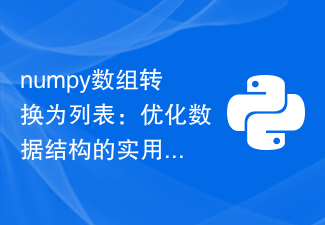
Practical Guide: How to flexibly use the numpy array splicing method
Introduction:
In the process of data analysis and scientific calculation, we often need to perform array processing Splicing operations to achieve combination and integration of data. Numpy is an important scientific computing library in Python. It provides a wealth of array operation functions, including a variety of array splicing methods. This article will introduce several commonly used Numpy array splicing methods and give specific code examples to help readers master their usage skills.
1. vstack and hstack
The vstack method is used to splice two arrays in the vertical direction, that is, to connect the arrays in the row direction. The hstack method is used to splice two arrays in the horizontal direction, that is, to connect the arrays in the column direction.
Code example:
import numpy as np
Create two arrays to be spliced
array1 = np.array([[1, 2, 3],
[4, 5, 6]])
array2 = np.array([[7, 8, 9],
[10, 11, 12]])
Use vstack for vertical splicing
result_vstack = np.vstack((array1, array2 ))
print("Vertical splicing result:", result_vstack)
Use hstack for horizontal splicing
result_hstack = np.hstack((array1, array2))
print( "Horizontal stitching result:", result_hstack)
Output example:
Vertical stitching result:
[[ 1 2 3]
[ 4 5 6]
[ 7 8 9]
[10 11 12]]
Horizontal splicing result:
[[ 1 2 3 7 8 9]
[4 5 6 10 11 12]]
二, concatenate function
The concatenate function can realize splicing operations in different directions by specifying axis parameters. The common parameters are 0 and 1, which represent splicing in the vertical and horizontal directions respectively.
Code Example:
import numpy as np
Create two arrays to be spliced
array1 = np.array([[1, 2, 3],
[4, 5, 6]])
array2 = np.array([[7, 8, 9],
[10, 11, 12]])
Use the concatenate function for splicing
result_vertical = np.concatenate((array1, array2), axis=0) # Concatenate in the vertical direction
result_horizontal = np.concatenate((array1, array2), axis=1) # Concatenate in the horizontal direction
print("Result of concatenating in the vertical direction:", result_vertical)
print("Horizontal splicing result:", result_horizontal)
Output example:
Vertical splicing result:
[[ 1 2 3]
[ 4 5 6]
[7 8 9]
[10 11 12]]
Horizontal splicing result:
[[ 1 2 3 7 8 9]
[ 4 5 6 10 11 12 ]]
3. Stack function extension
In addition to the above splicing methods, Numpy also provides the stack function, which can insert new dimensions at specified positions and perform splicing operations. The specific usage of the stack function is as follows:
Code example:
import numpy as np
Create two arrays to be spliced
array1 = np.array([1 , 2, 3])
array2 = np.array([4, 5, 6])
Use stack for splicing
result_vertical = np.stack((array1, array2) , axis=0) # Splicing in new dimensions
result_horizontal = np.stack((array1, array2), axis=1) # Splicing in new dimensions
print("Splicing results in new dimensions: ", result_vertical)
print("Splicing the result in the new dimension: ", result_horizontal)
Output example:
Splicing the result in the new dimension:
[[1 2 3]
[4 5 6]]
Splicing results in new dimensions:
[[1 4]
[2 5]
[3 6]]
Conclusion:
This article introduces the commonly used array splicing methods in Numpy, including vstack, hstack, concatenate and stack. Through actual code examples, readers can flexibly use these array splicing methods to combine and integrate data. In actual data analysis and scientific calculations, the rational use of these splicing methods can improve the efficiency and simplicity of the code and bring convenience to our work.
The above is the detailed content of A practical guide to numpy array splicing methods. For more information, please follow other related articles on the PHP Chinese website!
 numpy数组的list转换方法Jan 26, 2024 am 09:43 AM
numpy数组的list转换方法Jan 26, 2024 am 09:43 AM利用list转换为numpy数组的方法,需要具体代码示例在Python中,我们经常需要处理大量的数值数据,而numpy库是Python中常用的数值计算工具之一。它提供了丰富的数学函数和方便的数组操作功能。而在numpy中,通常使用numpy数组来存储和处理数据。在实际应用中,我们往往需要将其他数据结构,如list,转换为numpy数组进行后续的数值计算和分析
 PHP框架的实战指南:部署、维护、优化实战技巧Jun 01, 2024 am 10:04 AM
PHP框架的实战指南:部署、维护、优化实战技巧Jun 01, 2024 am 10:04 AM为了充分利用PHP框架的潜力,本文提供了实战技巧,包括:部署:选择合适环境、使用版本控制、自动化部署。维护:定期检查更新、性能监控、安全修补。优化:实施缓存、代码分析、优化数据库查询。通过遵循这些最佳实践,您可以确保您的PHP应用程序以最佳性能运行,并始终保持安全。
 深入学习Numpy数组的创建Feb 18, 2024 pm 11:32 PM
深入学习Numpy数组的创建Feb 18, 2024 pm 11:32 PMNumpy数组创建方法详解Numpy是Python中最常用的科学计算库之一,提供了强大的多维数组对象,能够高效地进行数值计算和数据分析。在使用Numpy时,最常见的操作就是创建数组。本文将详细介绍Numpy中的数组创建方法,并给出具体的代码示例。使用array()函数创建数组最简单的创建数组的方法是使用array()函数。该函数可以接受一个序列(列表、元组等
 深入解析和实践Java正则表达式语法Jan 11, 2024 pm 05:13 PM
深入解析和实践Java正则表达式语法Jan 11, 2024 pm 05:13 PMJava正则表达式语法详解与实战指南引言:正则表达式是一种强大的文本处理工具,其可以通过一种特定的语法规则来匹配、查找和替换字符串。在Java编程语言中,可以通过Java.util.regex包提供的类来使用正则表达式。本篇文章将详细介绍Java正则表达式的语法,并提供实际的代码示例。一、基本语法:1.单个字符匹配:-字符类:用方括号[]表示,表示从字符列
 MySQL性能优化实战指南:深入理解B+树索引Jul 25, 2023 pm 08:02 PM
MySQL性能优化实战指南:深入理解B+树索引Jul 25, 2023 pm 08:02 PMMySQL性能优化实战指南:深入理解B+树索引引言:MySQL作为开源的关系型数据库管理系统,被广泛应用于各个领域。然而,随着数据量的不断增加和查询需求的复杂化,MySQL的性能问题也越来越突出。其中,索引的设计和使用是影响MySQL性能的关键因素之一。本文将介绍B+树索引的原理,并以实际的代码示例展示如何优化MySQL的性能。一、B+树索引的原理B+树是一
 给PHP开发者的直播功能实战指南May 21, 2023 pm 07:03 PM
给PHP开发者的直播功能实战指南May 21, 2023 pm 07:03 PMPHP是目前网站开发中最流行的语言之一,它的开放性、灵活性和高度可定制性使得它成为了许多公司、组织和个人首选的开发语言。在今天的数字化时代,通过直播技术来推广产品和服务已经成为一种很流行的营销方式。这篇文章将会给PHP开发者介绍直播技术,并提供一些实战指南,帮助他们快速搭建出一个高效的直播平台。初识直播技术直播技术是指通过互联网将实时音视频数据进行传输和播放
 numpy数组转换为列表:优化数据结构的实用技术Jan 19, 2024 am 10:38 AM
numpy数组转换为列表:优化数据结构的实用技术Jan 19, 2024 am 10:38 AM数据分析领域常用的Python库Numpy是一个基于数组的库,它提供速度快、高效和便捷的数学操作。Numpy中的数组是其最基础的数据结构,它是一个容易处理和操作的高维数列。在数据的预处理过程中,我们常常需要把Numpy中的数组转化为列表进行处理。本文将探讨如何将Numpy数组转换为列表,并提供具体的代码示例。一、Numpy数组和列表的区别在Numpy中,数组
 掌握Maven核心命令:从初级到高级,快速提升开发效率Jan 05, 2024 am 11:02 AM
掌握Maven核心命令:从初级到高级,快速提升开发效率Jan 05, 2024 am 11:02 AMMaven命令实战指南:从入门到精通,掌握核心命令,提升开发效率导语:作为Java开发人员,我们经常会使用到Maven这个强大的项目构建工具。它不仅可以管理项目的依赖关系,还可以帮助我们完成编译、测试、打包等一系列的任务。本文将介绍Maven的核心命令及其使用示例,帮助读者更好地理解和应用Maven,提升开发效率。一、Maven的核心命令mvncompil


Hot AI Tools

Undresser.AI Undress
AI-powered app for creating realistic nude photos

AI Clothes Remover
Online AI tool for removing clothes from photos.

Undress AI Tool
Undress images for free

Clothoff.io
AI clothes remover

AI Hentai Generator
Generate AI Hentai for free.

Hot Article

Hot Tools

Safe Exam Browser
Safe Exam Browser is a secure browser environment for taking online exams securely. This software turns any computer into a secure workstation. It controls access to any utility and prevents students from using unauthorized resources.

PhpStorm Mac version
The latest (2018.2.1) professional PHP integrated development tool

SublimeText3 Chinese version
Chinese version, very easy to use

MinGW - Minimalist GNU for Windows
This project is in the process of being migrated to osdn.net/projects/mingw, you can continue to follow us there. MinGW: A native Windows port of the GNU Compiler Collection (GCC), freely distributable import libraries and header files for building native Windows applications; includes extensions to the MSVC runtime to support C99 functionality. All MinGW software can run on 64-bit Windows platforms.

Dreamweaver CS6
Visual web development tools







